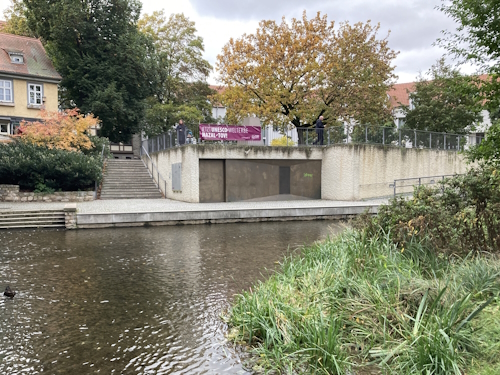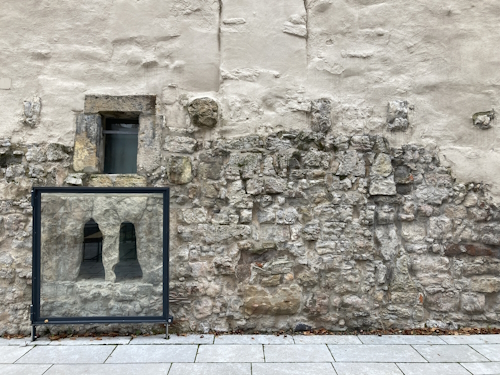Blog WHS Visits
WHS #875: Erfurt
So I have the honour to first review this site after inscription! Fortunately, it wasn’t as gloomy as I expected it - instead of the celebratory “Wir sind Welterbe” banners common in Germany, the components of this WHS displayed happy purple signs stating “Jetzt UNESCO Welterbe - Mazal-Tov!”. Even the infamous Stone House (component #3), which was previously hard to recognize, now stands out in its street.
I don’t know whether Erfurt normally sees a lot of tourists, but on the Thursday in late October when I visited many tour groups were led through its historic center; mostly German, some Asian. I could overhear their guides talking about the newly gained World Heritage Status. I also happily explored its streets with its eclectic architecture, visited the Cathedral, the St Severus' Church, and the Citadel, and ate a hearty lunch. But after that, I couldn’t postpone the Jewish Heritage sites anymore.
The Old Synagogue seems to have gotten more accustomed to receiving visitors - you get a proper ticket plus an audio guide or a booklet on loan that explains the site and Erfurt’s Jewish history. One enters via a small courtyard and then has three floors to cover in the building itself. They did their best to fill it with relevant items and I seriously started reading in the provided guide, but after a few minutes it gets to you: there is nothing authentic of any relevance to be seen here. It’s like being in one of these caves where hominid fossils were found - one where the cave has been altered beyond recognition that is.
The top floor shows the remains of the dance hall it once was, and the basement holds the Erfurt Treasure (I think the discovery of this provided the tipping point to apply for WH status, but these are moveable objects that were not even found at one of the inscribed locations). When the building was a synagogue, there was neither a basement nor a top floor by the way.
Further disappointment followed at the Mikveh. I had read online that there is a tour every Thursday and Saturday. But at the advertised hour of 4 p.m., no one showed up. Only then I noticed a small note next to the door of the Mikveh entrance, saying "Only tours on Saturday, they have to be pre-booked and start at the synagogue". Grrr. It turned out to be a classical mistake of the English version of an official website not having been updated while the German version was. I sent an e-mail to the contact address given, they never replied and the error persists.
I feel for the well-meaning citizens of Erfurt, who so diligently have uncovered this part of their city’s history and should continue to cherish them as a local treasure. This recent article describes how it all came about.
I do not sympathize so much with those who oversee the German nominations and ICOMOS. There is a question in the FAQ of Erfurt's official website, asking why this Jewish heritage was nominated instead of the Old City or some of its more notable monuments. The answer: “Jewish heritage is underrepresented. Medieval and Christian heritage and historic old towns, however, are disproportionately represented in Germany and Europe. A further application with such a topic would therefore no longer be accepted by UNESCO.” So the golddiggers at the German national committee saw a high chance of inscription (Fills a Gap!) - no matter that there are already 95 sites with Jewish heritage on the list, and 10 mikvehs, and Germany itself is probably the most overrepresented within the overrepresented Europe/North America region. This is not equal to Kazimierz or the Old New Synagogue in Prague or even to the SHuM sites. The Jewish sites of Erfurt never had any influence beyond the city borders, not in their architecture nor in their spiritual meaning.
ICOMOS did give them a bit of a hard time in the preliminary stages - Germany needed the submission of over 400 pages of supplementary information and a lot of adjectives in describing the OUV to convince ICOMOS. It lost one criterion and an Epic Subtitle along the way, losing the intangible link of coexistence with the Christian majority.
Stripped to the bare bones, the narrow narrative now consists of the oldest known remains of an Ashkenazi synagogue (but what if we find an older one tomorrow? – Jews have been present in this part of Europe for centuries before), a Mikveh that only stands out for its “spatial distribution” (which means that it was built a few streets away from the synagogue as the surrounding area had no space anymore), and wooden beams painted with some decorative flowers in the ceiling in the once Jewish owned Stone House.
If they just had nominated the Erfurt Cathedral and St Severus' Church (a former TWHS) or Erfurt’s Central-European townscape of medieval origin (including the Jewish sites) I could have lived with it. Erfurt overall is pleasant enough for a few hours and superficially it isn’t much different from Quedlinburg or Bamberg. I would have given it 2 or 2.5 stars, and complained a bit about “same old, same old” but what they got now is one of the poorest WHS on the list, for both intrinsic value and visitor experience.
Els - 5 November 2023


